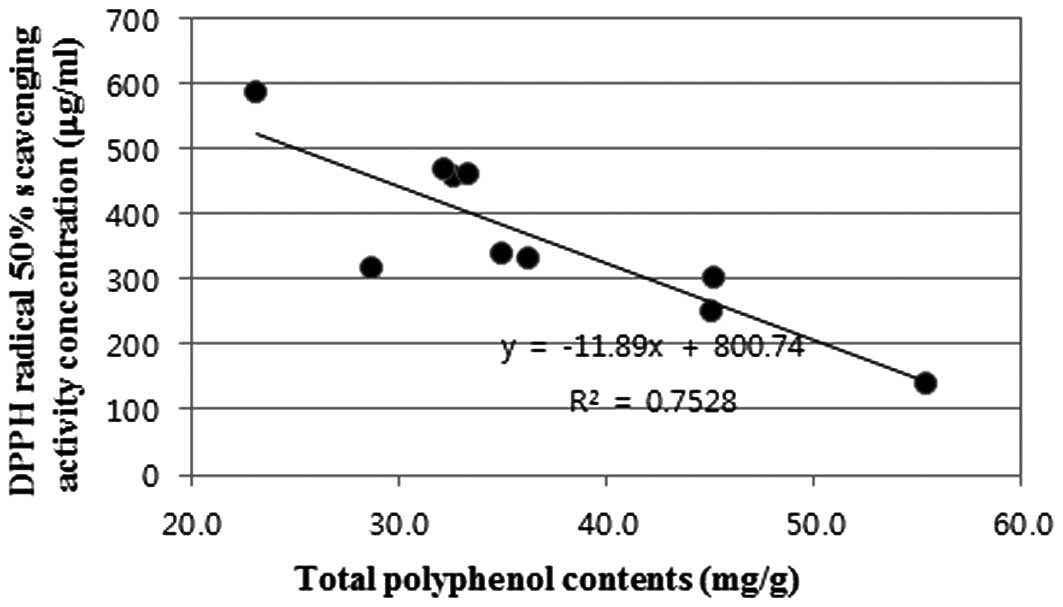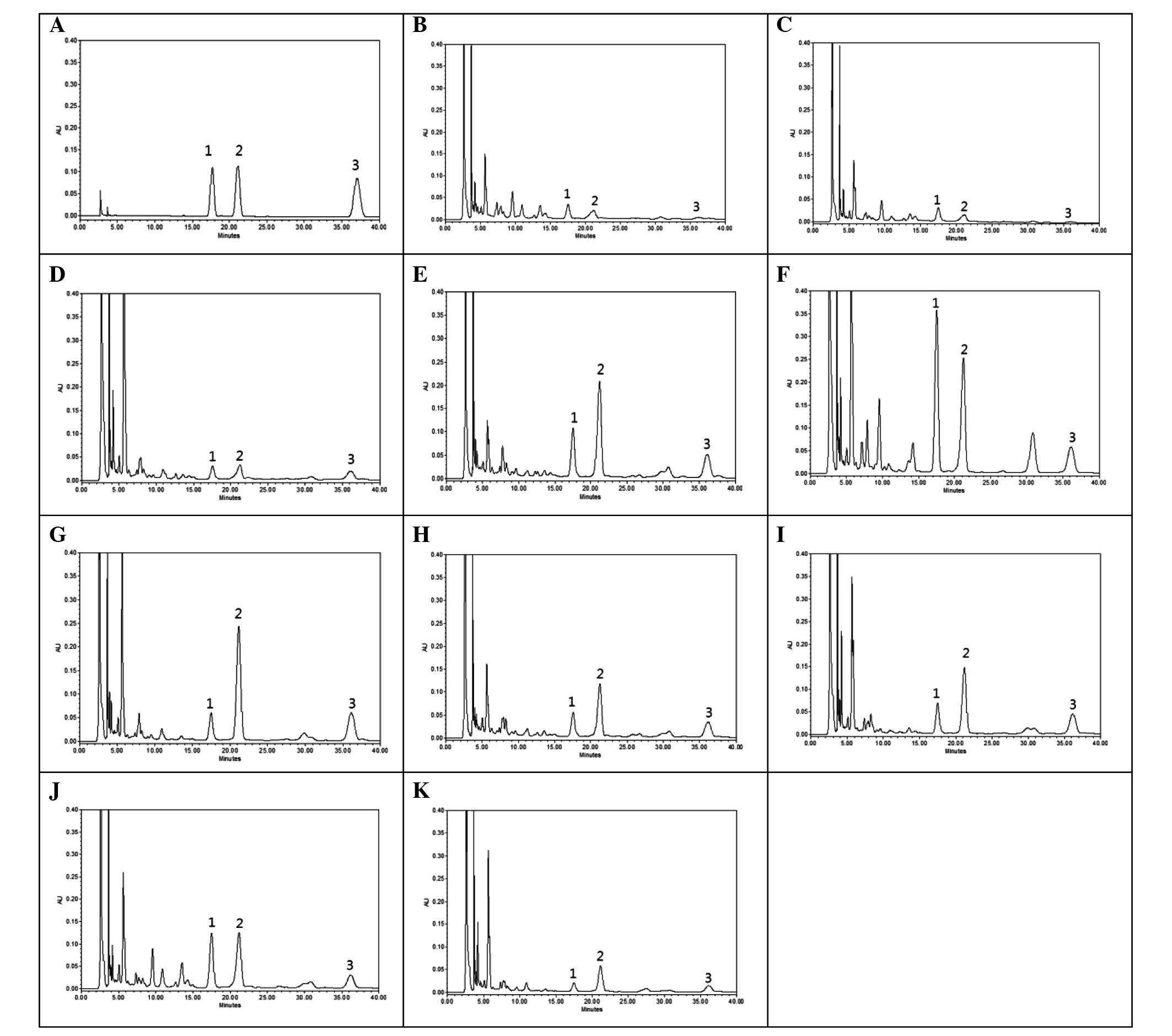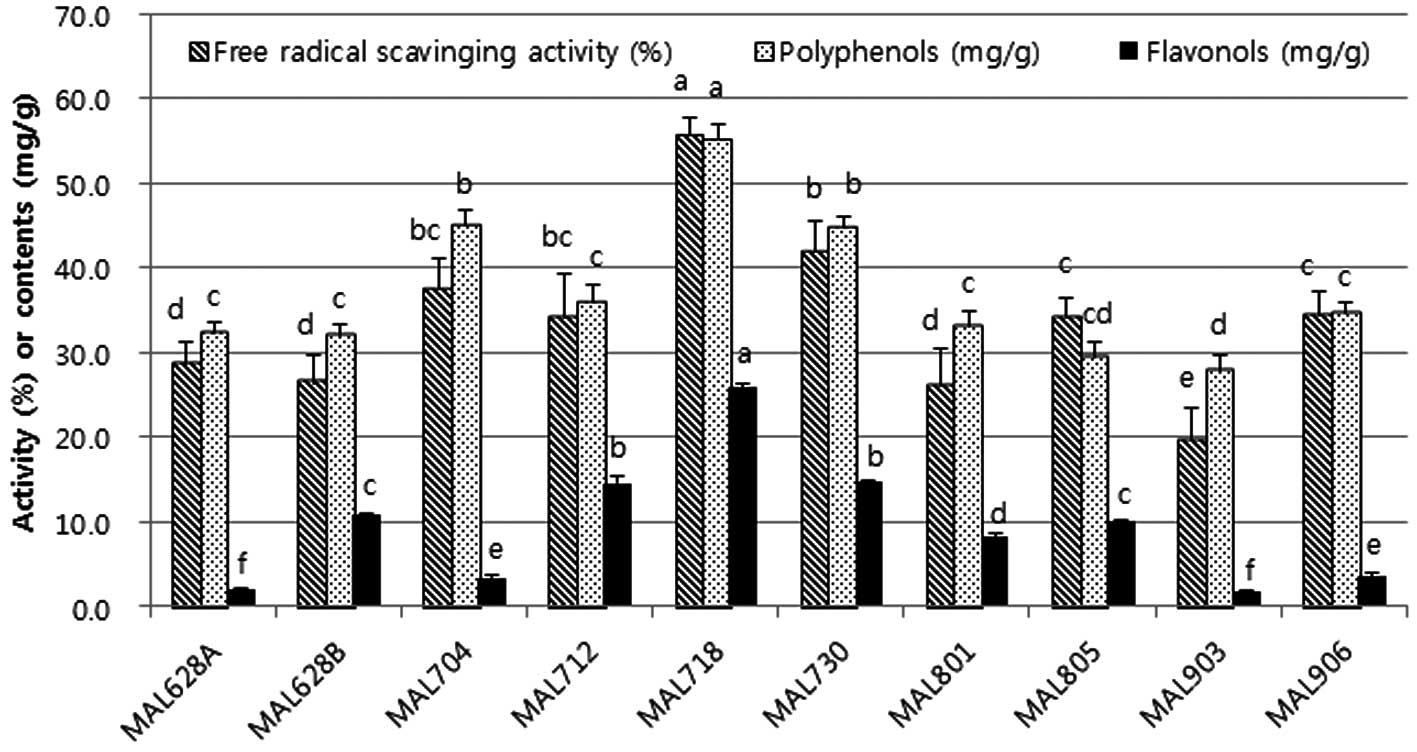|
1
|
Heo J: Dong-eui-bo-gam. 14751610.(In
Korean).
|
|
2
|
Yang MY, Huang CN, Chan KC, Yang YS, Peng
CH and Wang CJ: Mulberry leaf polyphenols possess antiatherogenesis
effect via inhibiting LDL oxidation and foam cell formation. J
Agric Food Chem. 59:1985–1995. 2011. View Article : Google Scholar : PubMed/NCBI
|
|
3
|
Naowaboot J, Pannangpetch P,
Kukongviriyapan V, Kukongviriyapan U, Nakmareong S and Itharat A:
Mulberry leaf extract restores arterial pressure in
streptozotocin-induced chronic diabetic rats. Nutr Res. 29:602–608.
2009. View Article : Google Scholar : PubMed/NCBI
|
|
4
|
Yang NC, Jhou KY and Tseng CY:
Antihypertensive effect of mulberry leaf aqueous extract containing
γ-aminobutyric acid in spontaneously hypertensive rats. Food Chem.
132:1796–1801. 2012.
|
|
5
|
Oh KS, Ryu SY, Lee S, Seo HW, Oh BK, Kim
YS and Lee ΒΗ: Melanin-concentrating hormone-1 receptor antagonism
and anti-obesity effects of ethanolic extract from Morus
alba leaves in diet-induced obese mice. J Ethnopharmacol.
122:216–220. 2009. View Article : Google Scholar : PubMed/NCBI
|
|
6
|
Park JM, Bong HY, Jeong HI, Kim YK, Kim JY
and Kwon O: Postprandial hypoglycemic effect of mulberry leaf in
Goto-Kakizaki rats and counterpart control Wistar rats. Nutr Res
Pract. 3:272–278. 2009. View Article : Google Scholar : PubMed/NCBI
|
|
7
|
Katsube T, Yamasaki M, Shiwaku K, Ishijima
T, Matsumoto I, Abe K and Yamasaki Υ: Effect of flavonol glycoside
in mulberry (Morus alba L.) leaf on glucose metabolism and
oxidative stress in liver in diet-induced obese mice. J Sci Food
Agric. 90:2386–2392. 2010.PubMed/NCBI
|
|
8
|
Hsu LS, Ho HH, Lin MC, Chyau CC, Peng JS
and Wang CJ: Mulberry water extracts (MWEs) ameliorated carbon
tetrachloride-induced liver damages in rat. Food Chem Toxicol.
50:3086–3093. 2012. View Article : Google Scholar : PubMed/NCBI
|
|
9
|
Kim SY, Gao JJ, Lee WC, Ryu KS, Lee KR and
Kim YC: Antioxidative flavonoids from the leaves of Morus
alba. Arch Pharm Res. 22:81–85. 1999. View Article : Google Scholar : PubMed/NCBI
|
|
10
|
Katsube T, Imawaka N, Kawano Y, Yamazaki
Y, Shiwaku K and Yamane Y: Antioxidant flavonol glycosides in
mulberry (Morus alba L.) leaves isolated based on LDL
antioxidant activity. Food Chem. 97:25–31. 2006.
|
|
11
|
Mok JY, Jeong SI, Kim JH and Jang SI:
Synergic effect of quercetin and astragalin from mulberry leaves on
anti-inflammation. Kor J Ori Physiol Pathol. 25:830–836. 2011.
|
|
12
|
Bravo L: Polyphenols: chemistry, dietary
sources, metabolism, and nutritional significance. Nutr Rev.
56:317–333. 1998.PubMed/NCBI
|
|
13
|
Kähkönen MP, Hopia AI, Vuorela HJ, Rauha
JP, Pihlaja K, Kujala TS and Heinonen M: Antioxidant activity of
plant extracts containing phenolic compounds. J Agric Food Chem.
47:3954–3962. 1999.PubMed/NCBI
|
|
14
|
Middleton E Jr, Kandaswami C and
Theoharides TC: The effects of plant flavonoids on mammalian cells:
implications for inflammation, heart disease and cancer. Pharmacol
Rev. 52:673–751. 2000.PubMed/NCBI
|
|
15
|
Soobrattee MA, Neergheen VS, Luximon-Ramma
A, Aruoma OI and Bahorun T: Phenolics as potential antioxidant
therapeutic agents: mechanism and actions. Mutat Res. 579:200–213.
2005. View Article : Google Scholar : PubMed/NCBI
|
|
16
|
Aruoma OI: Free radicals, oxidative
stress, and antioxidants in human health and disease. J Am Oil Chem
Soc. 75:199–212. 1998. View Article : Google Scholar
|
|
17
|
Fang J, Seki T and Maeda H: Therapeutic
strategies by modulating oxygen stress in cancer and inflammation.
Adv Drug Deliv Rev. 61:290–302. 2009. View Article : Google Scholar : PubMed/NCBI
|
|
18
|
Doi K, Kojima T and Fujimoto Y: Mulberry
leaf extract inhibits the oxidative modification of rabbit and
human low density lipoprotein. Biol Pharm Bull. 23:1066–1071. 2000.
View Article : Google Scholar : PubMed/NCBI
|
|
19
|
Folin O and Denis W: On
phosphotungstic-phosphomolybdic compounds as color reagents. J Biol
Chem. 12:239–243. 1912.
|
|
20
|
Blois MS: Antioxidant determinations by
the use of a stable free radical. Nature. 181:1199–1200. 1958.
View Article : Google Scholar
|
|
21
|
Li X, Wu X and Huang L: Correlation
between antioxidant activities and phenolic contents of radix
Angelicae sinensis(Danggui). Molecules. 14:5349–5361. 2009.
View Article : Google Scholar : PubMed/NCBI
|
|
22
|
Navarro-Núñez L, Lozano ML, Palomo M,
Martínez C, Vicente V, Castillo J, Benavente-García O, Diaz-Ricart
M, Escolar G and Rivera J: Apigenin inhibits platelet adhesion and
thrombus formation and synergizes with aspirin in the suppression
of the arachidonic acid pathway. J Agric Food Chem. 56:2970–2976.
2008.PubMed/NCBI
|
|
23
|
Jung CH, Lee JY, Cho CH and Kim CJ:
Anti-asthmatic action of quercetin and rutin in conscious
guinea-pigs challenged with aerosolized ovalbumin. Arch Pharm Res.
30:1599–1607. 2007. View Article : Google Scholar : PubMed/NCBI
|
|
24
|
Reddy GB, Muthenna P, Akileshwari C,
Saraswat M and Petrash JM: Inhibition of aldose reductase and
sorbitol accumulation by dietary rutin. Curr Sci. 101:1191–1197.
2011.
|
|
25
|
Razavi SM, Zahri S, Zarrini G, Nazemiyeh H
and Mohammadi S: Biological activity of quercetin-3-O-glucoside, a
known plant flavonoid. Bioorg Khim. 35:414–416. 2009.PubMed/NCBI
|
|
26
|
Rogerio AP, Kanashiro A, Fontanari C, da
Silva EV, Lucisano-Valim YM, Soares EG and Faccioli LH:
Anti-inflammatory activity of quercetin and isoquercitrin in
experimental murine allergic asthma. Inflamm Res. 56:402–408. 2007.
View Article : Google Scholar : PubMed/NCBI
|
|
27
|
Choi J, Kang HJ, Kim SZ, Kwon TO, Jeong SI
and Jang SI: Antioxidant effect of astragalin isolated from the
leaves of Morus alba L. against free radical-induced
oxidative hemolysis of human red blood cells. Arch Pharm Res.
36:912–917. 2013.PubMed/NCBI
|
|
28
|
Lee HB, Kim EK, Park SJ, Bang SG, Kim TG
and Chung DW: Isolation and anti-inflammatory effect of astragalin
synthesized by enzymatic hydrolysis of tea seed extract. J Sci Food
Agric. 91:2315–2321. 2011. View Article : Google Scholar : PubMed/NCBI
|

















